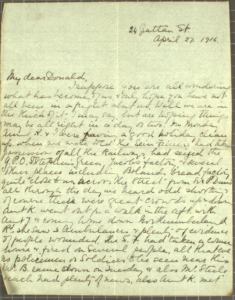
My father’s parents were Irish, and I had family in Dublin so I have always felt very settled here. A few years ago I was looking at old family documents and realised I had been living in the same area of Dublin where my dad’s father had grown up. This established a further connection with Dublin for me and sparked an interest in my family history.
Some time ago, my dad gave me a box of family letters and clippings from his uncle. In the collection were letters written by my three Great Great Aunts who were living together on Grattan Street in Dublin 2 during the Easter Rising. I think they were working in some capacity for the Smyly’s Boys Home at the end of their street. The letters describe the events and news of people they had seen and day to day happenings on the street.

The letter that I contributed to the Letters of 1916 collection was written on 27 April 1916 by Sarah Harden (1870-1929). Sarah wrote the letter to her nephew, Donald Harden, who was then living in England. Sarah Harden was a clerk at the Mission Homes in Dublin and lived on Grattan Street with her two sisters (Aunt K. and Aunt J. in the letter). The letter was written during and after the Easter Rising, which had begun on 24 April. Sarah began writing on 27 April and continued to add to the letter until 3 May by which time the postal system had resumed work. She gives a detailed description of her activities during the Rising, what she had seen and heard, rumours and stories told to her by others. She refers regularly to friends, relations and neighbours.
These letters have inspired me to produce a piece of work about 1916 as part of my M.A. I found out about the Letters of 1916 Project from a friend and since then I have participated in workshop for secondary school teachers in which we designed a history module for transition year students. The archive of letters is extremely valuable and I plan to use it for research in the future. I am excited by the project’s ability to discover a new layer and network of history.